Last updated: September 2023
When adopting a CRM with marketing automation capabilities, you could see a 25% increase in your return on investment.
But few know this type of result is impacted by the type of solution you choose.
If you’re looking to use CRM and marketing automation systems you’ve got two options:
- Pick-and-mix: Connect several specialized tools yourself to leverage the full benefits of each while avoiding data siloes.
- All-in-one: Drop a chunk of change on a single platform that handles everything.
In this post, I’ll show you some great options for keeping sales and marketing data together and help you decide whether you want to opt for an all-in-one platform or pick and mix best-of-breed tools.
But first…
What is the pick-and-mix method for using CRM with marketing automation?
The pick-and-mix method (also known as the best-of-breed approach) involves taking two or more existing tools and combining them to create a new, more comprehensive solution. This can be done through various ways: native add-ons, integration platforms, and by creating custom connectors.
For instance, you can connect your CRM such as Copper with an email marketing automation solution such as Mailchimp to keep data synced and take advantage of top features from both solutions. Without the extra price tag.
While you won’t end up with a standalone platform, the idea is that it gives you the freedom to use the tools you already love and trust and their most advanced functionalities.
When to pick this method:
- You want to work with best-of-breed tools because they tend to focus on one thing and do this one thing really well
- You want quick results using the tool stack you already have and you don’t have the time to train your team to use a new tool
- You want a solution that gives you the flexibility to respond to market changes
- You want to experiment with a variety of marketing strategies or tools without committing to anything specific
Drawbacks to keep an eye on:
- Some tools might not be straightforward to connect to various other apps
- You need to manage each of the tools and vendors separately
- If you’re just starting out, setting up each tool will take longer than using one single solution as you’ll need to buy, set up, and learn each product
What is the all-in-one method?
An all-in-one (suite) method uses a single-vendor solution to manage your CRM and marketing automation efforts from one platform through dedicated, native, and often extensive capabilities.
Marketing and sales cloud suites were originally very popular solutions that allowed teams to handle multiple operations from a single place. While these give marketers a holistic look at their campaigns, they also come with a set of limitations, reducing a marketer’s experimentation options and boxing them in.
When to pick this method:
- Saves you time because you don’t need to spend time learning multiple new tools
- You only want to research and manage one software vendor
Drawbacks to keep an eye on:
- All-in-one suites are usually notably more expensive
- All-in-one solutions don’t always offer the diversity or complexity of features and workflows you need, limiting the capability of your marketing campaigns
- It doesn’t allow for much experimentation as you’ll always be limited to the capabilities your tool of choice provides
- You’re fully reliant on a single software provider so if anything happens (e.g. vendor gets hacked, customer service isn’t responsive, etc.), it will impact the entirety of your marketing efforts
Why would you want to integrate marketing automation with your CRM?
Without a doubt, you’ll get the most benefits out of your CRM tool by connecting it to your marketing automation solutions.
Some of the benefits of uniting marketing automation integrations with your CRM include:
- Helping marketing teams understand marketing’s revenue contribution, by allowing them to link marketing efforts with outcome.
- Helping sales teams close deals faster by scoring and filtering leads based on engagement and interest.
- Keeping customer data in sync across multiple platforms, so your team will be able to trust these numbers and insights for campaigns they’re working on.
- Easily eliminate duplicate data to make sure you’re not using false reporting and avoid compliance issues.
Pitfalls of keeping your CRM separate from other marketing automation tools you’re using
Here’s my own take on the matter.
I’m a freelancer/consultant myself. Before that, I was an in-house marketer, often in a department of one. I use CRM with a marketing automation platform out of sheer necessity: I can’t afford to not have these two functions exist together.
That’s because I simply need to have all of my customer data under one hub. This way, I don’t have to waste hours looking through multiple sources or scouring through different tools.
Not to mention that making sure I had access to the latest data was one of the biggest issues I encountered with each client. There was always a faulty data field that wouldn’t update in real-time, so you’d end up sending an email to the wrong person or showing in-app pop-ups to users who had unsubscribed from them.
Some of the other problems you might experience as a result of this lack of connectivity:
- You’re likely to spend too much time on otherwise simple admin tasks.
- You can’t measure ROI on specific campaigns because everything is siloed into different systems with no connectivity between them.
- You don’t have an accurate picture of the profile and activity of your prospects and customers.
- You can’t customize your marketing or sales campaigns.
- You’ll never be sure whether the data you have in any of the tools is actually up-to-date and reliable.
- You’ll simply be making guesses instead of informed decisions for future campaigns and tactics.
And I know that just like me, you also don’t want (and simply don’t have the time) to deal with these “side effects”.
So let me show you just what I do to keep the CRM with marketing automation connection rolling.
CRM and marketing automation: Tools for the Pick-and-Mix method
This is my #1 choice every time. I prefer to connect multiple specialized tools because each of them provides the advanced features and workflows I need. This means I don’t ever have to worry about the classic “My tool can’t do that” problem.
I’m going to take you through some of the approaches I’ve had hands-on experience with.
There’s something for every price point on this list. For the sake of clarity, each solution is listed with price 💰 and functionality ✔️ scores on a 5-point scale.
1. Pipedrive CRM + Mailchimp + Outfunnel
Price: 💰💰
Features: ✔️✔️✔️
Super-simple cost calculation (3 users): $117/month
Pipedrive is the best CRM for pipeline management, but it gets really expensive (double the price) as soon as you want to add in even basic marketing automation functions.
In fact, most of Pipedrive’s best features come at a premium cost.
Their Essential plan isn’t really that well specced. You’ve got your lead and deal pipeline, access to over 400 integrations, 24/7 support, and that’s it.
It lacks pretty much any advanced sales or marketing functionality though. Pipedrive does offer an automation builder through their Advanced plan, but it’s rather basic as it doesn’t have advanced features like journeys, A/B testing, or landing pages. On top of this, the plan is also missing other features like reporting, scalable account permissions, or complex pipeline handling.
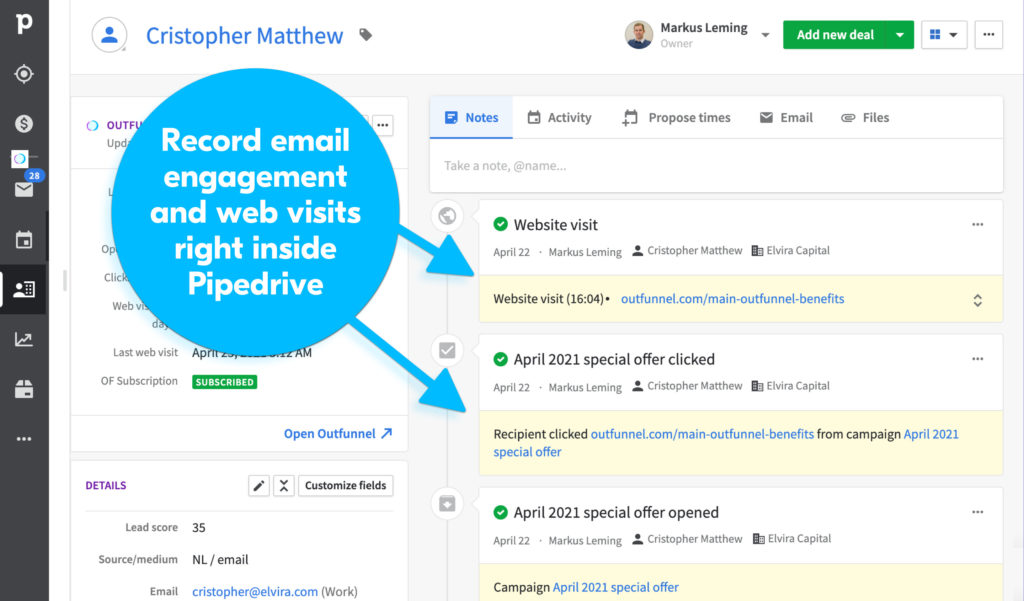
That’s where Outfunnel and Mailchimp step in. These are some of the workflows that are in your arsenal with a Pipedrive + Outfunnel + Mailchimp pick-and-mix setup:
- Sync Pipedrive CRM contacts to Mailchimp audiences automatically, along with default and custom fields, keeping email lists up to date 24/7.
- Send automated marketing campaigns to Pipedrive contacts with Mailchimp
- Automatically record Mailchimp opens, clicks, unsubscribes, and bounces in Pipedrive for better context for your sales team.
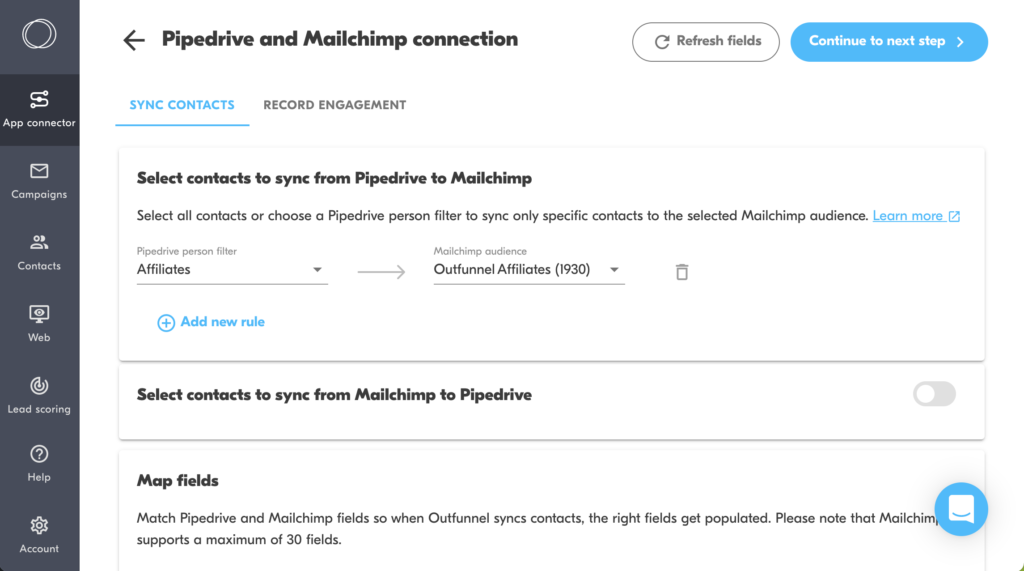
Combine the Pipedrive CRM with Outfunnel and Mailchimp, and you get access to all the marketing automation you need and some super-handy sales automation capabilities to boot.
And by the way, Outfunnel is rated as the #1 best Pipedrive integration on their app marketplace.
2. HubSpot (Free or Starter) CRM + ActiveCampaign + Outfunnel
Price: 💰💰💰
Features: ✔️✔️✔️
Super-simple cost calculation (3 users): $127/month
Few people know you can actually use HubSpot for free. The only catch? The free tools are basic. And costs get out of control when you want to add more extensive marketing automation functions.
But free doesn’t always mean free.
HubSpot actually appears twice here, once as a pick-and-mix option, and again as a standalone solution. That’s because HubSpot is in fact many different products, all living under one umbrella.
So next, we’re looking at just their Sales Hub with the Starter pricing plan.
At this price point ($18/month), it’s pretty well specced. You’ve got your deal pipeline, some simple automations, and quotes. Basic reporting comes in handy too, plus the live chat sweetens the deal.
But what you get from HubSpot’s Marketing Free and Starter plans is pretty basic. You’ll get much more powerful marketing automation features when using ActiveCampaign instead.
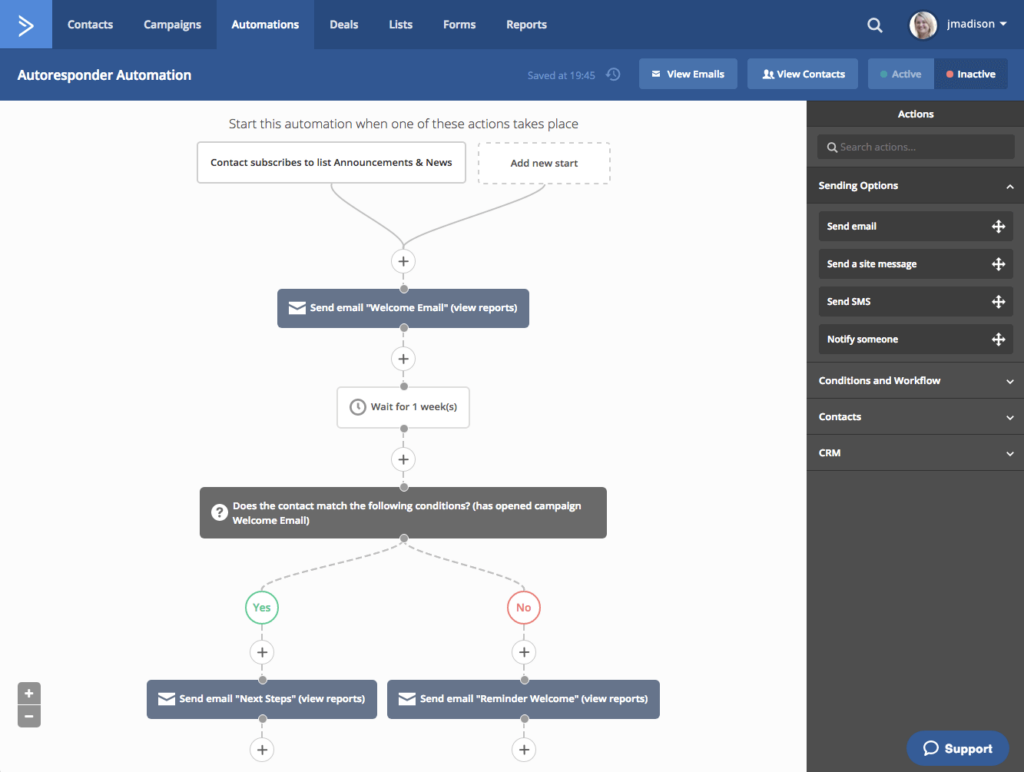
Some of the advanced marketing functionalities ActiveCampaign will provide include:
- SMS automation
- Lead scoring
- Split automations
- AI content generation
- Predictive sending
- Marketing revenue reports and store performance
- Attribution tracking
You can then use Outfunnel to connect HubSpot and ActiveCampaign.
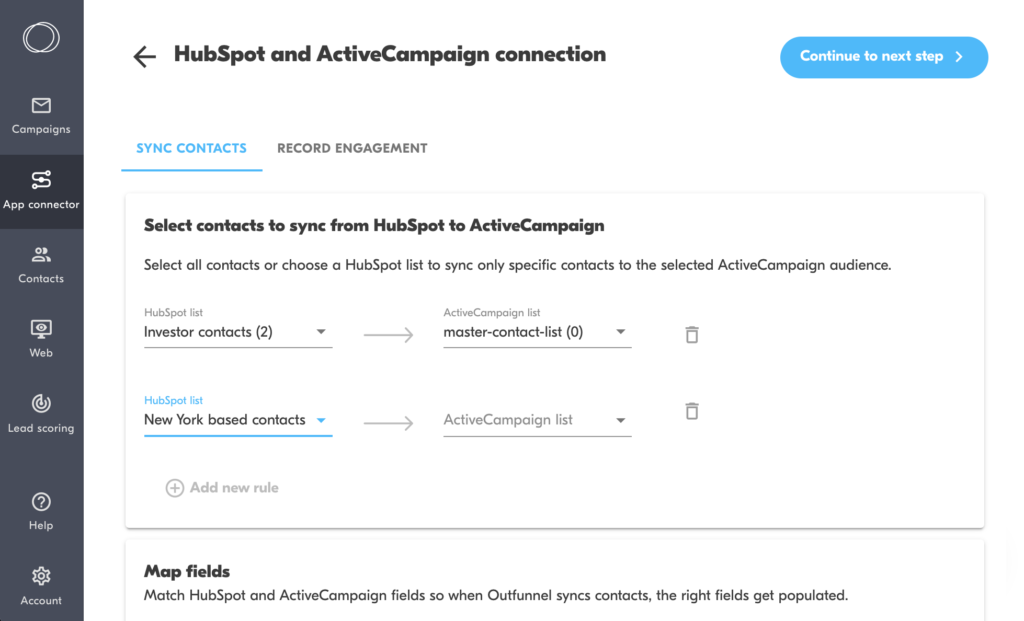
This way, you’ll have your sales CRM sending contacts to your marketing automation platform, which in return syncs email engagement and website visitor data to contacts in HubSpot, to support sales efforts. This allows you to build super personalized marketing campaigns, in sync with the sales cycle and easily identify high-quality, sales-ready leads in the CRM.
Further, you can have Outfunnel sync new marketing contacts, i.e. ActiveCampaign subscribers to HubSpot CRM as contacts, so sales don’t miss any marketing qualified opportunities.
Outfunnel also combines the user behaviors and engagement data to generate lead scores, which then sync back to HubSpot.
3. Capsule CRM + Brevo + Zapier
Price: 💰
Features: ✔️✔️
Super-simple cost calculation (3 users): $54/month
Capsule is a CRM that offers a diverse range of features at a relatively low price point. For just $18/month/user you get access to pretty much all of their features including CRM, project management, email templates, team collaboration, and basic reporting. Throw in some security features and 24/7 support and you’ve got yourself what seems like the deal of the century.

But this plan is missing automation capabilities.
Plus, this Workflow Automation product isn’t even built for email. For this, Capsule prompts you to purchase their email product: Transpond. But an unlimited plan for Transpond is very expensive. Also, Transpond is more limited when it comes to functionalities than Brevo.
So you’ll want to try to connect it to an email tool like Brevo (formerly Sendinblue) to get:
- Marketing automation
- SMS and WhatsApp campaigns
- A/B testing
- Advanced transactional emails
- Send time optimization
This is a brilliant combo of tools but you can only connect them lightly via Zapier.
The only thing you can do via Zapier to connect Capsule and Brevo is sync specific contacts and updates from Capsule to Brevo.
Zapier also gets expensive to use if you want multi-step Zaps, custom logic paths, or unlimited users. Not to mention the cheaper plans are limited to a series of basic apps you can connect with.
CRM and marketing automation: Software for the All-in-One approach
All-in-one tools have been popular thanks to their ability to do everything. But within today’s digital landscape, they’re not only struggling to keep up with market demands, but they’re also more expensive and often require consultants for implementation, customization, or bug fixing.
1. Salesforce Sales + Marketing Cloud
Price: 💰💰💰💰💰
Features: ✔️✔️✔️✔️✔️
If you need a platform that does everything, Salesforce is worth a look. It’s probably overkill for many small businesses, but there’s no denying its power.
When it comes to business intelligence and development, you can do pretty much anything inside the Salesforce ecosystem: marketing, eCommerce, analytics, automation, customer service, and retention.
But there are a few key features that really make Salesforce the industry leader for enterprise-level budgets: custom reports, onboarding, and extensive integration options.
Some would even argue that Salesforce is too reporting-centric, but it’s certainly become more intuitive for salespeople over the years.
Then there are the Salesforce integrations. Not only does Salesforce lead the pack when it comes to pre-built 3rd party integrations (there are 2,500+ solutions on their AppExchange marketplace). On top of this, you can build your own integrations through MuleSoft Anypoint (separate cost for this too), which is essentially a management tool for custom API integrations.
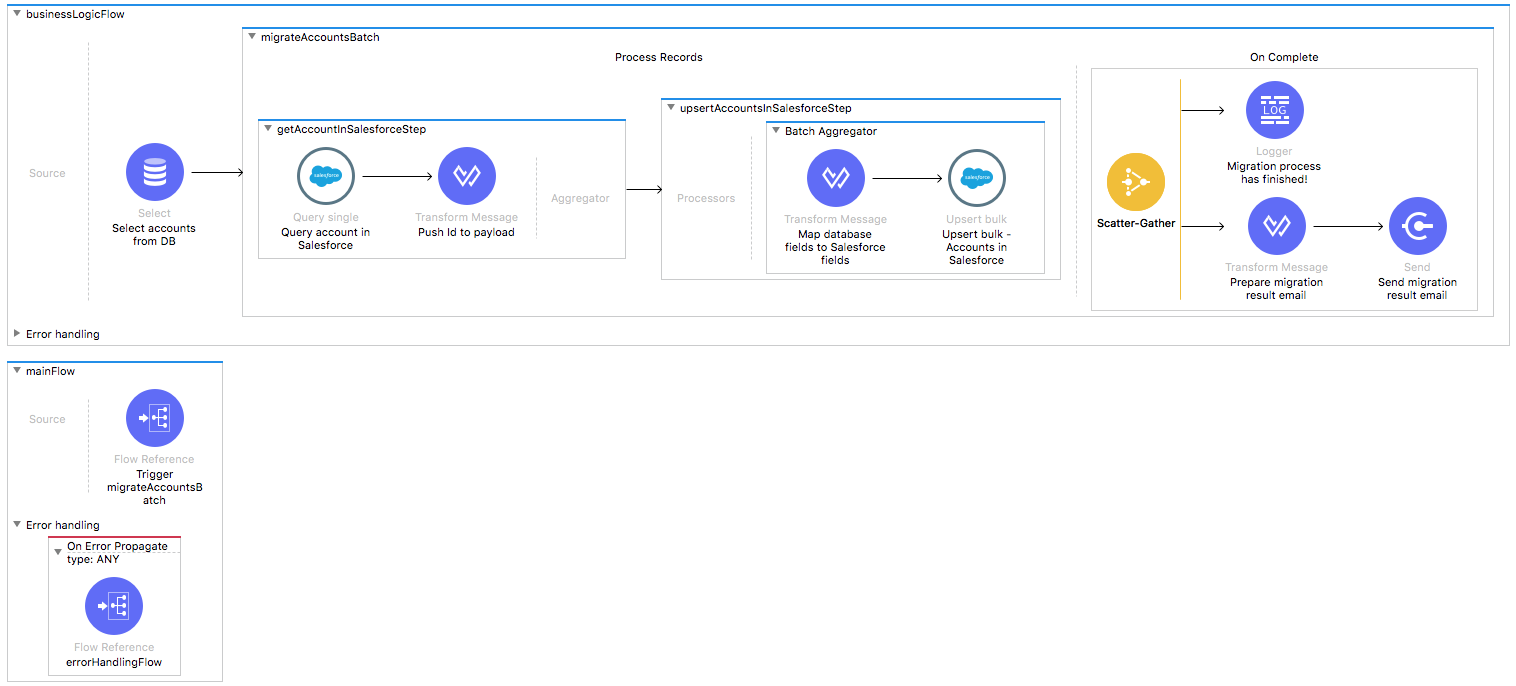
But the costs of a solution like this are outrageous. Not to mention their pricing schemes are incredibly complex and confusing.
Their most basic Marketing Cloud starts at $1250 USD a month. For up to 10,000 contacts. If you pay annually.
That’s an upfront cost of $15,000 USD. For just this the marketing cloud product.
So, in real terms, if you want to have enough Salesforce to cover yourself and say two other users, and you want to be able to handle very basic marketing and sales automation, you’re looking at an annual cost of $16,000.

That’s $1,500 for the sales tools and $15,000 for the marketing automation. At this price level, you start digging through the complex feature set and you’ll quickly find that some pretty key stuff, like automated lead scoring requires you to jump to the next pricing level, taking you to a total cost of $17,700 per year.
So, while Salesforce’s all-encompassing approach to CRM and marketing automation has created a thriving business for them, for you it comes at the cost of some usability and $$$’s.
P.S. We’ve worked on Salesforce-ActiveCampaign and Salesforce-Mailchimp integrations for those who like the leading CRM, but not necessarily the price of Salesforce’s own products.
2. HubSpot’s Professional plan
Price: 💰💰💰💰
Features: ✔️✔️✔️✔️✔️
These days it’s pretty hard to split Salesforce and HubSpot. Their key features are on par with one another, but as with Salesforce, if you want to use HubSpot’s own marketing automation options, be prepared to pay the price (you could, of course, choose a third-party HubSpot marketing automation solution instead).
The free version of Sales Hub, HubSpot’s sales CRM, is pretty much everything you need to get started.
You get nice Kanban-style pipeline management, some basic business intelligence features, email tracking and notifications, meeting scheduling, and lots more.
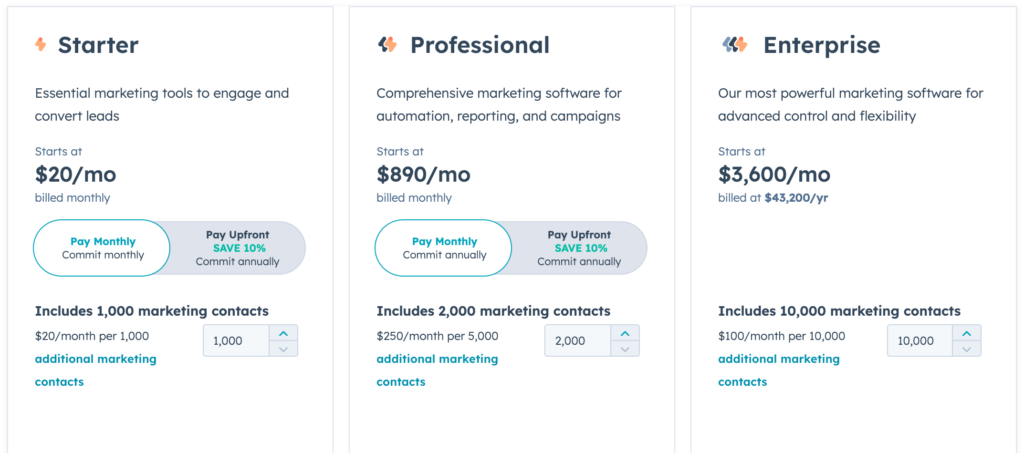
But this plan is dedicated to startups that have just launched their operations. And you’re here to look beyond just the sales CRM functionality.
Before we dive into what HubSpot’s marketing automation looks like, let’s talk for a moment about what they offer in terms of marketing features in general.
The word I’d use to describe the features is “robust”. You’ve got everything from web forms, to ad management, messenger integration, content management systems for your website and blog, landing page builder, and everything in between.
You can build automated email marketing workflows to handle tasks like rotating leads from inbound marketing to sales and make sure the right internal and external messages get sent out. You can also add delays and conditional logic as well.
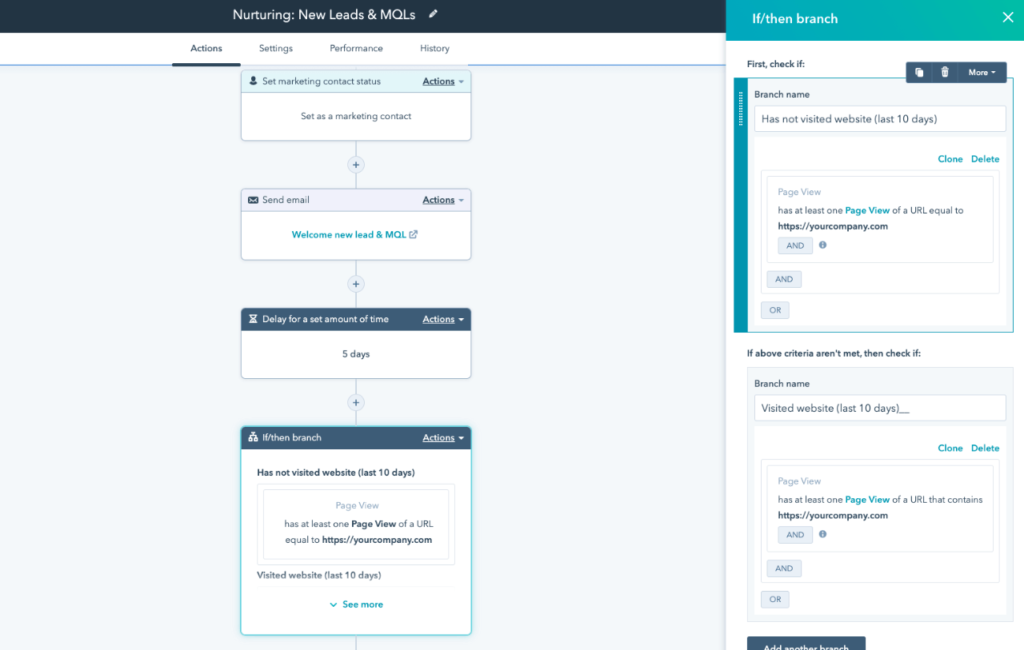
Something that I’ve found particularly useful is the visual workflow builder. It’s a really elegant way of creating workflows, from how to capture leads to turning qualified leads into customers. When I’m brainstorming any process like a marketing funnel, I typically start it on paper, on a whiteboard, or in something like Whimsical (highly recommend this, by the way).
HubSpot’s marketing automation software also comes at a pretty significant cost, though. That’s because while the free and starter tier offer some marketing capabilities, automation isn’t one of them. So, the professional tier is where you’ll look for HubSpot marketing automation.
And how much is the Professional tier?
It starts at $880 a month. And that’s just for the marketing hub. HubSpot does offer some bundling of solutions at a reduced price, which is nice of them. So, for the Professional Growth Suite (which gets you Sales Hub® Pro, Marketing Hub® Pro, and some other useful goodies) you’ll be handing over a whopping $1410 per month.
The mere fact that you need the help of either a dedicated in-house ops person or consultants to manage it is enough to make it impossible to use for smaller businesses or consultants like me.
Wrapping it all up
At the end of the day, it comes down to finding the best setup that suits your budget and team’s needs while allowing you to set up an excellent customer experience for leads.
For many, the big ticket prices of the all-in-one solutions are perfectly reasonable. The benefit of having everything under one roof outweighs the dollar cost that comes with it.
But really, for a lot of us, the primary need is having all of the data in one place, rather than necessarily the advanced features we use to aggregate that data.
Most all-in-one CRM tools include their advanced features in higher-priced plans even if these are actually essential for a marketer or salesperson’s job.
If your marketing and sales teams are small or simply won’t use most features under a plan, chances are you likely aren’t going to need those expensive subscriptions.
You’re going to risk spending money on technology that just kind of sits there.
So you’re better off choosing simpler plans from one or two tools and connecting them via a solution like Outfunnel.
If you decide to go with Pipedrive, Copper, Salesforce, or HubSpot be sure to connect your sales and marketing data with Outfunnel. Get started with a free 14-day trial (no credit card required).




